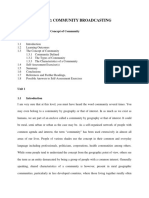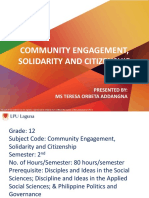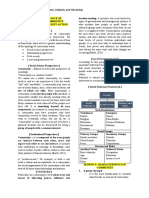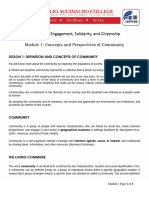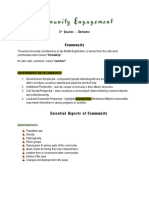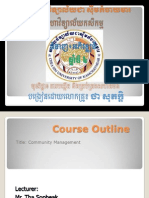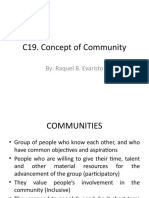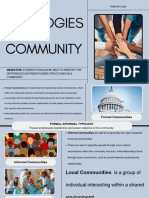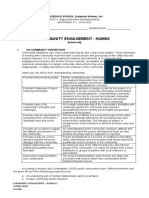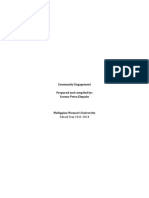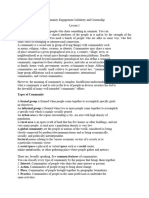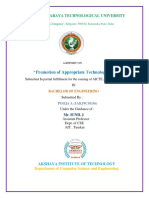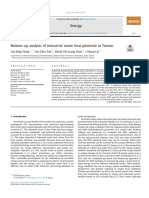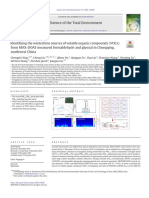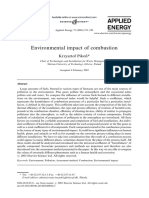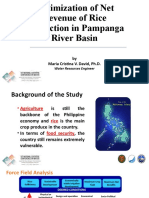Module 2
Uploaded by
jeanampo07Module 2
Uploaded by
jeanampo071
MODULE 2: COMMUNITY: DEFINITIONS, DIMENSIONS, CAPITALS AND
RELATED CONCEPTS
A. THE COMMUNITY
Community Development and Social Development: Informing Concepts Goodsell, Flaherty, and
Brown (2014) define community as “a form of social organization wherein the social interactions
necessary for the reproduction of daily life occur within the boundaries of moral
proximity” journals.sagepub.com
Cambridge Dictionary defines community as “the people living in
one particular area or people who are considered as a unit because
of their common interests, social group, or nationality: local community, Asian community, gay
community, international community, sense of community.
The IGI Global defines community as “A social unit based on commonality – for example common
values, beliefs, interests, roles.” https://www.igi-global.com/dictionary/community/4696
The University of Minnesota Extension Program defines community as "Community, in its most
basic definition, can be defined as individuals who share a common interest, background or
purpose that gives them a sense of cohesion."
B. Traditional Vs. Modern Definition of Community
The traditional and modern definitions of community in the context of community development
differ in their understanding of the concept and its implications for community development
practices.
1. Traditional Definition
The traditional definition of community emphasizes the importance of shared experiences,
social bonds, and collective action. It views community as a cohesive group of people who
share common values, interests, and goals, often with a strong sense of belonging and identity.
This definition is rooted in the idea that community is a natural and essential aspect of human
life, where people come together to support each other and work towards common objectives.
2. Modern Definition
The modern definition of community, on the other hand, is more nuanced and recognizes the
complexities and diversity of modern societies. It acknowledges that communities are not
always homogeneous and that differences in culture, identity, and interests can be valuable
assets. This definition emphasizes the importance of inclusivity, diversity, and social justice,
recognizing that communities must be open to change, difference, and the needs of all
members.
3. Key Differences
▪ Homogeneity vs. Diversity: Traditional definitions often assume a homogeneous
community, whereas modern definitions acknowledge and celebrate diversity.
▪ Collective Action vs. Individual Agency: Traditional definitions emphasize collective
action and shared goals, whereas modern definitions recognize the importance of
individual agency and the need for inclusive decision-making processes.
MODULE 2: The Community: Definitions, Dimensions, Capitals & Related Concepts
CD 111 – Introduction to Community Development
Roel S. Sayson, MSCD | USeP-CDM, Mintal, Davao City, Philippines
2
MODULE 2: COMMUNITY: DEFINITIONS, DIMENSIONS, CAPITALS AND
RELATED CONCEPTS
▪ Static vs. Dynamic: Traditional definitions often view community as a static entity,
whereas modern definitions see community as dynamic and constantly evolving in
response to changing circumstances and needs.
▪ Focus on Shared Values vs. Shared Needs: Traditional definitions focus on shared
values and common goals, whereas modern definitions prioritize shared needs and
the well-being of all community members.
4. Implications for Community Development
The traditional definition of community often leads to a focus on building strong social bonds
and fostering collective action. This approach can be effective in small, homogeneous
communities where shared values and goals are clear. However, in modern, diverse societies,
this approach can be limiting and even exclusionary.
In contrast, the modern definition of community emphasizes inclusivity, diversity, and social
justice. This approach recognizes that communities are complex and dynamic, and that
individual agency and diverse perspectives are essential for effective community development.
This perspective encourages community development practitioners to engage with diverse
stakeholders, foster inclusive decision-making processes, and prioritize the needs of all
community members.
Conclusion
The traditional and modern definitions of community in the context of community development
reflect different understandings of the concept and its implications for community development
practices. While the traditional definition emphasizes shared values and collective action, the
modern definition acknowledges diversity and prioritizes inclusivity, social justice, and
individual agency. Understanding these differences is crucial for effective community
development that respects and values the diversity of modern societies.
References:
[1] https://assets.cambridge.org/97805217/11081/excerpt/9780521711081_excerpt.pdf
[2] https://www.strongtowns.org/journal/2019/6/14/traditional-development
[3]
https://www.ourcommunity.com.au/files/ourconsumerplace/CDANDMENTALHEALTHBOOK.pd
f
[4] https://typeset.io/pdf/a-comparative-analysis-of-the-role-of-traditional-and-modern-
d0ok7ra21p.pdf
Activity 2: Reaction/Reflection Paper
1. Select 1 definition of Community Development and make a reaction on it.
2. https://www.nacdep.net/assets/docs/select%20definitions%20of%20community%2
0development%201.pdf
C. Types of Community
The concept of community encompasses various forms and categories, each with distinct
characteristics. Here are some of the main types of communities:
Location-Based Communities
MODULE 2: The Community: Definitions, Dimensions, Capitals & Related Concepts
CD 111 – Introduction to Community Development
Roel S. Sayson, MSCD | USeP-CDM, Mintal, Davao City, Philippines
3
MODULE 2: COMMUNITY: DEFINITIONS, DIMENSIONS, CAPITALS AND
RELATED CONCEPTS
1. Rural Communities: Based in villages and dependent on agriculture, with low population
densities and close social relationships [1][4].
2. Urban Communities: Found in cities, with higher population densities, diverse
occupations in services and industry, and less close social ties [1][4].
3. Tribal Communities: Living in isolated forest or hill areas, with distinct cultures and
languages, and united under a tribal chief [1].
Identity-Based Communities
1. Ethnic Communities: Based on shared ethnicity, culture, or language [2].
2. Religious Communities: United by shared religious beliefs and practices [2].
3. Multicultural Communities: Comprising people from diverse ethnic, cultural, and
religious backgrounds [2].
Organization-Based Communities
1. Informal Communities: Organized around family or network-based guilds and
associations [2].
2. Formal Communities: Incorporated associations, political decision-making structures,
economic enterprises, or professional associations [2].
Intentional Communities
1. Ecovillages: Residential communities with a common social or spiritual purpose, focusing
on sustainability and environmentalism [2].
2. Housing Cooperatives: Residential communities where members own and manage their
homes collectively [2].
Other Types of Communities
1. Virtual Communities: Formed through communication platforms and shared online spaces
[2].
2. Global Communities: Comprising people from different parts of the world, often united by
shared interests or values [2].
3. Sectoral Communities: Based on shared professional or occupational interests [5].
Categorizations of Community Relations
1. Grounded Community Relations: Involving enduring attachment to particular places
and people, common in customary and tribal communities[2].
2. Life-Style Community Relations: Focused on shared ways of life, such as morally
charged or interest-based relations[2].
Purpose-Based Communities
1. Interest-Based Communities: United by shared interests or passions[3].
2. Action-Based Communities: Comprising people trying to bring about change[3].
3. Place-Based Communities: Brought together by geographic boundaries[3].
4. Practice-Based Communities: Comprising people in the same profession or undertaking
the same activities[3].
5. Circumstance-Based Communities: Formed by external events or situations[3].
These categories help to understand the diverse forms and purposes that communities can
take, reflecting the complexities and nuances of human social organization.
MODULE 2: The Community: Definitions, Dimensions, Capitals & Related Concepts
CD 111 – Introduction to Community Development
Roel S. Sayson, MSCD | USeP-CDM, Mintal, Davao City, Philippines
4
MODULE 2: COMMUNITY: DEFINITIONS, DIMENSIONS, CAPITALS AND
RELATED CONCEPTS
References:
[1] https://www.slideshare.net/slideshow/types-of-community/250945184
[2] https://en.wikipedia.org/wiki/Community
[3] https://www.feverbee.com/different-types-of-communities/
[4] https://www.slideshare.net/slideshow/community-types-urban-rural-and-
suburban/4512151
[5] https://www.scribd.com/presentation/463067147/Types-of-Communities
D. Elements of a Community
1. Nature of a Community
▪ A community is a sociological construct
The concept of community is not only a “construct” (model); it is a sociological
construct or a set of interactions or human behaviors that have meaning and
expectation between its members
▪ A community has fuzzy boundaries
It is the nature where the boundary of the community I no longer that precise.
▪ A community can exist within a larger community
It is a community inside a larger community, including districts, regions or other
interactions that link the communities of a nation together.
▪ A community may move
When technology is not based on local horticulture, the community residents may
be physically mobile.
2. Power of a Community
▪ It is the capacity to influence decision-making and distribution processes, to bring
about change and get things done.
Bases of Local
Description
Community Power
It is the capacity to create linkages and develop helpful
Connections relationships with powerful individuals, family, and
organizations
It is the base, back-up, and support of the people in the
Power in Number
community.
It is the ability to provide awards, promotions, money, and
Rewards gifts that are useful to meet individual or organizational
goals.
Personal Traits/ It is the capacity to foster respect and loyalty based on
Expertise charm, talents, and skills.
It is the leadership title or higher organizational or
Legitimate Power
institutional position.
Information It is the ability to share good information.
Coercion It is influenced through manipulation and coercion.
3. Structure of a Community
Community structure refers to the organization of a community into distinct groups or sub-
systems that are interconnected and interdependent. This concept is relevant in various
contexts, including ecology, sociology, community development and network science.
i. Ecological Context
MODULE 2: The Community: Definitions, Dimensions, Capitals & Related Concepts
CD 111 – Introduction to Community Development
Roel S. Sayson, MSCD | USeP-CDM, Mintal, Davao City, Philippines
5
MODULE 2: COMMUNITY: DEFINITIONS, DIMENSIONS, CAPITALS AND
RELATED CONCEPTS
In ecology, community structure refers to the arrangement of species within a community. It
encompasses the abundances of species present and their interactions, which can be
influenced by various factors such as environmental conditions and evolutionary processes
[2].
ii. Sociological Context
In sociology, community structure can be viewed as a system comprising economic,
political, and social sub-systems. These sub-systems are interconnected and
interdependent, influencing the overall functioning of the community. For example,
economic factors can impact social dynamics, and political structures can shape economic
activities [1].
iii. Network Science Context
In network science, community structure refers to the grouping of nodes in a network based
on their connections. Nodes within a community are densely connected, and less
connected to nodes outside the community. This concept is used to understand complex
networks, such as social networks, biological networks, and computer networks, where
identifying communities can provide insights into network function and topology[4].
Importance of Community Structure
Understanding community structure is crucial in various contexts:
▪ Ecological Research: Identifying community structure can help ecologists
understand how species interact and how environmental factors influence these
interactions.
▪ Sociological Research: Understanding community structure can inform policies
and interventions aimed at improving social cohesion and addressing social issues.
▪ Network Analysis: Identifying community structure in networks can provide insights
into network function, topology, and processes such as information spreading or
epidemic spreading.
Conclusion
Community structure is a fundamental concept that helps us understand the organization
and dynamics of communities across different disciplines. It is essential to recognize the
interconnectedness and interdependence of different sub-systems within a community to
effectively analyze and address various issues.
References:
[1] https://ebooks.inflibnet.ac.in/aep05/chapter/understanding-the-concept-of-
community/
[2] https://evol-eco.blogspot.com/2013/11/community-structure-what-are-we-
missing.html
[3] https://ctb.ku.edu/en/table-of-contents/assessment/assessing-community-needs-and-
resources/describe-the-community/main
[4] https://en.wikipedia.org/wiki/Community_structure
[5] https://www.slideshare.net/slideshow/community-structurespdf/255550843
4. The key elements that define a community are:
MODULE 2: The Community: Definitions, Dimensions, Capitals & Related Concepts
CD 111 – Introduction to Community Development
Roel S. Sayson, MSCD | USeP-CDM, Mintal, Davao City, Philippines
6
MODULE 2: COMMUNITY: DEFINITIONS, DIMENSIONS, CAPITALS AND
RELATED CONCEPTS
i. Group of People: A community is fundamentally a group of people living together and
sharing a common life.
ii. Locality: A community is defined by a specific geographic area or territory where the
group of people reside.
iii. Community Sentiment: There is a strong sense of belonging, shared identity, and
emotional connection among the members of the community.
iv. Naturality: Communities are naturally formed, not artificially created, and people
become members through birth or residence.
v. Permanence: A community is a relatively stable and permanent group, not a temporary or
transient association.
vi. Similarity: Members of a community share similarities in aspects like language, culture,
customs, traditions, and way of life.
vii. Organized Social Life: A community encompasses all aspects of social life and functions
as a miniature society.
viii. Particular Name: Each community has a distinct name by which it is identified.
ix. No Legal Status: Communities do not have any formal legal status or rights and duties
defined by law.
x. Size: Communities can vary in size from small villages to large nations, with smaller
communities often being part of larger ones.
These elements collectively define the concept of community and distinguish it from other
types of social groups and associations. The presence and interplay of these factors shape the
nature and dynamics of a community.
References:
[1] https://www.slideshare.net/slideshow/elements-of-community/239553484
[2] https://www.yourarticlelibrary.com/society/13-most-important-characteristics-or-elements-
of-community/6231
[3] https://www.lawrist.com/community-meaning-definitions-and-elements
[4] https://www.barrycf.org/about/7-elements-of-a-healthy-community/
[5] https://brainly.ph/question/3616546
E. Dimension of Culture/Community
Many of us work routinely with people from other cultures and backgrounds.
Often this goes well, and the cultural differences are interesting and enriching. However,
sometimes things go wrong, for reasons that we may not understand.
This is where it's important to understand the differences between cultures, so that we can work
MODULE 2: The Community: Definitions, Dimensions, Capitals & Related Concepts
CD 111 – Introduction to Community Development
Roel S. Sayson, MSCD | USeP-CDM, Mintal, Davao City, Philippines
7
MODULE 2: COMMUNITY: DEFINITIONS, DIMENSIONS, CAPITALS AND
RELATED CONCEPTS
with people more effectively, and prevent misunderstandings.
Trompenaars and Hampden-Turner's Seven Dimensions of Culture help us do this. We'll look at
the seven dimensions in this article, and we'll explore how you can apply the model in your own
situation.
The Seven Dimensions of Culture were identified by management consultants Fons
Trompenaars and Charles Hampden-Turner, and the model was published in their 1997 book,
"Riding the Waves of Culture."
Trompenaars and Hampden-Turner developed the model after spending 10 years
researching the preferences and values of people in dozens of cultures around the world. As
part of this, they sent questionnaires to more than 46,000 managers in 40 countries.
They found that people from different cultures aren't just randomly different from one
another; they differ in very specific, even predictable, ways. This is because each culture has its
own way of thinking, its own values and beliefs, and different preferences placed on a variety of
different factors.
Trompenaars and Hampden-Turner concluded that what distinguishes people from one culture
compared with another is where these preferences fall in one of the following seven
dimensions:
1. Universalism versus particularism.
2. Individualism versus communitarianism.
3. Specific versus diffuse.
4. Neutral versus emotional.
5. Achievement versus ascription.
6. Sequential time versus synchronous time.
7. Internal direction versus outer direction.
We'll look at each dimension in detail below.
You can use the model to better understand people from different cultural backgrounds so that
you can prevent misunderstandings and enjoy a better working relationship with them. This is
especially useful if you do business with people from around the world, or if you manage a
diverse group of people.
The model also highlights that one culture is not necessarily better or worse than another;
people from different cultural backgrounds simply make different choices.
However, the model doesn't tell you how to measure people's preferences on each
dimension. Therefore, it's best to use it as a general guide when dealing with people from
different cultures.
How to Apply the Seven Dimensions
Let's look at each of the dimensions in detail and explore some of the strategies that you can
use with people who fit the characteristics highlighted in each dimension.
MODULE 2: The Community: Definitions, Dimensions, Capitals & Related Concepts
CD 111 – Introduction to Community Development
Roel S. Sayson, MSCD | USeP-CDM, Mintal, Davao City, Philippines
8
MODULE 2: COMMUNITY: DEFINITIONS, DIMENSIONS, CAPITALS AND
RELATED CONCEPTS
Note 1:
For each dimension, we've included some of the national cultures that Trompenaars and
Hampden-Turner identified as having a preference at each extreme of that particular dimension.
You can use this as a general guide, but remember to treat people as individuals and to avoid
stereotyping.
Note 2:
The cultural dimensions don't consider people's personal experiences or
differences between sub-cultures within the country, so bear this in mind when you're
applying the model. This is especially relevant in today's global environment, where
people can be influenced by many different cultures.
Note 3:
Be sensible in how you apply these strategies. In practice, there will be many other
factors that will have a bearing on how you manage people and communicate with them.
1. Universalism Versus Particularism (Rules Versus Relationships)
Dimension Characteristics Strategies
People place a high ▪ Help people understand how their work
importance on laws, ties into their values and beliefs.
rules, values, and ▪ Provide clear instructions, processes,
obligations. They try to and procedures.
Universalism deal fairly with people ▪ Keep promises and be consistent.
based on these rules, ▪ Give people time to make decisions.
but ▪ Use an objective process to make
rules come before decisions yourself, and explain your
relationships. decisions if others are involved.
People believe that ▪ Give people autonomy to
each circumstance make their own decisions.
and each relationship ▪ Respect others' needs when you make
dictates the rules that decisions.
they live by. Their ▪ Be flexible in how you make decisions.
Particularism
response to a situation ▪ Take time to build relationships and get
may change, based on to know people so that you can better
what's happening at understand their needs.
the moment, and ▪ Highlight important rules and policies
who's involved. that need to be followed.
Typical universalist cultures include the U.S., Canada, the U.K, the Netherland
2. Individualism Versus Communitarianism (The Individual Versus The Group)
Dimension Characteristics Strategies
▪ Praise and reward individual
People believe in
performance.
personal freedom and
▪ Give people autonomy to make their
achievement. They
own decisions and to use their initiative.
Individualism believe that you make
▪ Link people's needs with those of the
your own decisions
group or organization.
and that you must take
▪ Allow people to be creative and to learn
care of yourself.
from their mistakes.
People believe that the ▪ Praise and reward group performance.
Communitarianism
group is more ▪ Don't praise individuals publicly
MODULE 2: The Community: Definitions, Dimensions, Capitals & Related Concepts
CD 111 – Introduction to Community Development
Roel S. Sayson, MSCD | USeP-CDM, Mintal, Davao City, Philippines
9
MODULE 2: COMMUNITY: DEFINITIONS, DIMENSIONS, CAPITALS AND
RELATED CONCEPTS
important than the ▪ Allow people to involve others in
individual. The group decision-making.
provides help and ▪ Avoid showing favoritism.
safety, in exchange for
loyalty. The group
always comes before
the individual.
Typical individualist cultures include the U.S., Canada, the U.K, Scandinavia, NewZealand,
Australia, and Switzerland.
Typical communitarian cultures include countries in Latin America, Africa, and Japan.
3. Specific Versus Diffuse (How Far People Get Involved)
Dimension Characteristics Strategies
People keep work and
personal lives
separate. As
a result, they believe
that relationships
▪ Be direct and to the point.
don't have
▪ Focus on people's objectives before you
much of an impact on
focus on strengthening relationships.
work objectives, and,
Specific ▪ Provide clear instructions, processes,
although good
and procedures.
relationships are
▪ Allow people to keep their work and
important, they
home lives separate.
believe that people
can work together
without
having a good
relationship.
People see an overlap
between their work
and personal life. They ▪ Focus on building a good relationship
believe that good before you focus on
relationships are vital business objectives.
to meeting business ▪ Find out as much as you can about the
objectives, and that people that you work with and the
Diffuse their relationships with organizations that you do business with.
others will be the ▪ Be prepared to discuss business on
same, whether they social occasions, and to have personal
are at work or meeting discussions at work.
socially. People spend ▪ Try to avoid turning down invitations to
time outside work social functions.
hours with colleagues
and clients.
Typical specific cultures include the U.S., the U.K., Switzerland, Germany, Scandinavia,
and the Netherlands.
Typical diffuse cultures include Argentina, Spain, Russia, India, and China.
4. Neutral Versus Emotional (How People Express Emotions)
MODULE 2: The Community: Definitions, Dimensions, Capitals & Related Concepts
CD 111 – Introduction to Community Development
Roel S. Sayson, MSCD | USeP-CDM, Mintal, Davao City, Philippines
10
MODULE 2: COMMUNITY: DEFINITIONS, DIMENSIONS, CAPITALS AND
RELATED CONCEPTS
Dimension Characteristics Strategies
People make a great
effort to control their ▪ Manage your emotions effectively.
emotions. Reason ▪ Watch that your body language doesn't
influences their convey negative emotions.
actions far ▪ "Stick to the point" in meetings and
Neutral
more than their interactions.
feelings. People don't ▪ Watch people's reactions carefully, as
reveal they may be reluctant to show their true
what they're thinking emotions.
or how they're feeling.
People want to find
▪ Open up to people to build trust and
ways to express their
rapport.
emotions, even
▪ Use emotion to communicate your
spontaneously, at
objectives.
Emotional work. In
▪ Learn to manage conflict effectively,
these cultures, it's
before it becomes personal.
welcome and
▪ Use positive body language.
accepted to
▪ Have a positive attitude.
show emotion.
Typical neutral cultures include the U.K., Sweden, the Netherlands, Finland, and
Germany.
Typical emotional cultures include Italy, France, Spain, and countries in Latin America
5. Achievement Versus Ascription (How People View Status)
Dimension Characteristics Strategies
People believe that
you are what you do,
▪ Reward and recognize good
and they base your
performance appropriately.
Achievement worth accordingly.
▪ Use titles only when relevant.
These cultures value
▪ Be a good role model.
performance, no
matter who you are.
People believe that
▪ Use titles, especially when these clarify
you should be valued
people's status in an organization.
for who you are.
▪ Show respect to people in authority,
Power, title, and
Ascription especially when challenging decisions.
position matter in
▪ Don't "show up" people in authority.
these cultures, and
▪ Don't let your authority prevent you from
these roles define
performing well in your role.
behavior.
Typical achievement cultures include the U.S., Canada, Australia, and Scandinavia.
Typical ascription cultures include France, Italy, Japan, and Saudi Arabia.
6. Sequential Time Versus Synchronous Time (How People Manage Time)
Dimension Characteristics Strategies
People like events to ▪ Focus on one activity or project at a
Sequential
happen in order. They time.
Time
place a high value on ▪ Be punctual.
MODULE 2: The Community: Definitions, Dimensions, Capitals & Related Concepts
CD 111 – Introduction to Community Development
Roel S. Sayson, MSCD | USeP-CDM, Mintal, Davao City, Philippines
11
MODULE 2: COMMUNITY: DEFINITIONS, DIMENSIONS, CAPITALS AND
RELATED CONCEPTS
punctuality, planning ▪ Set clear deadlines.
(and sticking to your ▪ Keep to deadlines.
plans), and staying on
schedule. In this
culture, "time is
money," and people
don't appreciate it
when their schedule is
thrown off.
People see the past,
present, and future as ▪ Be flexible in how you approach work.
interwoven periods. ▪ Allow people to be flexible on tasks and
Synchronous They often work on projects, where possible.
Time several projects at ▪ Highlight the importance of punctuality
once, and view plans and deadlines if these are key to
and commitments as meeting objectives.
flexible.
Typical sequential-time cultures include Germany, the U.K., and the U.S.
Typical synchronous-time cultures include Japan, Argentina, and Mexico
7. Internal Direction Versus Outer Direction (How People Relate to Their
Environment)
Dimension Characteristics Strategies
People believe that
Internal
they can control ▪ Allow people to develop their skills and
Direction
nature or their take control of their learning.
(This is
environment to ▪ Set clear objectives that people agree
also known
achieve goals. This with.
as having
includes how ▪ Be open about conflict and
an internal
they work with teams disagreement and allow people to
locus of
and within engage in constructive conflict.
control.)
organizations.
People believe that
nature, or their
▪ Provide people with the right resources
environment,
to do their jobs effectively.
controls them; they
▪ Give people direction and regular
Outer must work with their
feedback, so that they know how their
Direction environment to
actions are affecting their environment.
(This is achieve goals. At work
▪ Reassure people that they're doing a
also known or in relationships,
good job.
as having they focus their
▪ Manage conflict quickly and quietly.
an external actions on others,
▪ Do whatever you can to boost people's
locus of and they avoid conflict
confidence.
control.) where possible.
▪ Balance negative and positive feedback.
People often need
▪ Encourage people to take responsibility
reassurance that
for their work.
they're doing a good
job.
Typical internal-direction cultures include Israel, the U.S., Australia, New Zealand, and the U.K.
MODULE 2: The Community: Definitions, Dimensions, Capitals & Related Concepts
CD 111 – Introduction to Community Development
Roel S. Sayson, MSCD | USeP-CDM, Mintal, Davao City, Philippines
12
MODULE 2: COMMUNITY: DEFINITIONS, DIMENSIONS, CAPITALS AND
RELATED CONCEPTS
Typical outer-direction cultures include China, Russia, and Saudi Arabia.
Tip 1:
Hofstede's Cultural Dimensions is another model that can help you to understand different
cultures. The advantage of Hofstede's model is that his research included only employees from
one organization – IBM – so his findings are unlikely to be affected by differences in company
culture. The disadvantage is that the culture of this company may skew more general results.
Tip 2:
To learn more about managing and working with people from specific countries and cultures, see
the Managing Around the World articles in our Team Management section, and listen to our
Expert Interviews with Terri Morrison and Michael Schell .
Key Points
The Seven Dimensions of Culture model was created by Fons Trompenaars and Charles
Hampden-Turner, and was published in their book, "Riding the Waves of Culture." The model
says that what distinguishes people from one culture compared with another is where their
preferences fall on each of the following seven dimensions:
i. Universalism versus particularism.
ii. Individualism versus communitarianism.
iii. Specific versus diffuse.
iv. Neutral versus emotional.
v. Achievement versus ascription.
vi. Sequential time versus synchronous time.
vii. Internal direction versus outer direction.
You can use the model to better understand people from different cultural backgrounds so that you can
work with them more effectively and prevent misunderstandings. Be sensible in how you apply the
model. Treat people as individuals and remember that many factors will have a bearing on how you
communicate and interact with other people.
Reference: https://www.mindtools.com/a5ce21r/the-seven-dimensions-of-culture
F. Community Capitals
One of the challenges that local leaders and citizens constantly face is finding a coherent way to address
the variety of challenges facing their communities – be they urban, suburban, or rural in nature. In many
respects, most community and economic development initiatives intend to advance an area’s “quality of
life.” But what does “quality of life” mean and how is it measured? Is it the presence of a strong local
economy, sound local leadership, quality government services, top-notch public-supported schools,
great health care services, or other indicators? The simple answer is yes. In many respects, all of these
represent traits that would be associated with a community deemed to have a high quality of life.
As such, the issue at hand is to find a framework that captures the multi-dimensional nature of
community life. Most importantly, it must have been vetted in peer-reviewed scholarly journals and,
because of this process, found to be both scientifically and conceptually sound. Moreover, the
MODULE 2: The Community: Definitions, Dimensions, Capitals & Related Concepts
CD 111 – Introduction to Community Development
Roel S. Sayson, MSCD | USeP-CDM, Mintal, Davao City, Philippines
13
MODULE 2: COMMUNITY: DEFINITIONS, DIMENSIONS, CAPITALS AND
RELATED CONCEPTS
framework had to be one that could guide the “on-the-ground” efforts of community and economic
development practitioners.
With these important pre-conditions in mind, the perspective that one may find
appealing is the Community Capitals Framework (CCF), a perspective developed
and fine-tuned over a span of several years by Cornelia Butler Flora and Jan L. Flora
from Iowa State University (2008). The Floras suggest that the lifeblood of any
community can be linked to the presence and strength of seven community
capitals, resources that can be invested or tapped to promote the long-term well-
being of communities (Jacobs, 2011a).
The seven community capitals are natural, cultural, human, social, political,
financial, and built. Strong and resilient communities strive for balanced
investments in these seven capitals. If communities place too much emphasis on
one or two of the capitals, they can end up suppressing the growth of the other
community capitals, a condition that can damage the overall health of the
community. For example, places that invest aggressively in-built capital (through
the pursuit of bricks and mortar type of facilities) may contribute to the decline of
the community’s natural and cultural capital, especially if such facilities are
constructed in pristine areas or on lands that are part of the rich history of that
locality.
1 Natural Capital
Natural capital refers to “the landscape, air, water, soil, and biodiversity of both plants and
animals” (Flora and Flora, 2008) – in other words, our environment. It is also referred to in the
literature as “natural amenities” (McGranahan, 1999) – assets that are linked to a particular place,
such as weather, geographic location, natural resources, and natural beauty (Emery and Flora
2006). Since people and the communities of which they are a part are embedded in the
environment, one could argue that natural capital undergirds several of the other capitals. A
healthy and functioning environment provides valuable ecosystem services, such as food,
timber, wildlife habitat, flood control, and recreational opportunities, which are essential for
human life. Moreover, people and their communities are unable to thrive in areas where natural
capital is neglected and depleted.
2 Cultural Capital
The concept of culture provides a frame of reference for understanding the fabric of community
life. This fabric is often connected by a common language, symbols, gestures, beliefs, values, and
resources. In a classic textbook definition, culture consists of the material and nonmaterial
aspects of a way of life, which are shared and transmitted among members of a society (Rogers
et al., 1988). Culture is viewed as a “tool kit of symbols, stories, rituals, even the world-view that
shapes individuals” (Swidler,1986) It includes the values and symbols reflected in clothing,
music, industry, art, language, and customs. It also encompasses events, materials (paintings,
MODULE 2: The Community: Definitions, Dimensions, Capitals & Related Concepts
CD 111 – Introduction to Community Development
Roel S. Sayson, MSCD | USeP-CDM, Mintal, Davao City, Philippines
14
MODULE 2: COMMUNITY: DEFINITIONS, DIMENSIONS, CAPITALS AND
RELATED CONCEPTS
books), festivals, museums, and other activities occurring in communities (Flora and Flora,
2008).
3 Human Capital
In its simplest form, human capital reflects the investments that people make in their education,
onthe-job training, or health. Such activities translate into improved knowledge, skills, and health
status for individuals – factors that increase their human capital stock. As stocks improve,
productivity levels increase, resulting in higher earnings for these workers. Human capital also
refers to efforts by individuals to enhance their interpersonal and leadership skills in hopes of
strengthening their ability to become active contributing members to the civic health of their
communities (Flora and Flora, 2008).
The benefits of human capital investments are not accrued solely to individuals. Communities
with good shares of educated, healthy, and skilled workers also benefit, especially in their
capacity to remain resilient during periods of economic uncertainty. Places with a good base of
creative/knowledge-based workers, for example, tend to experience economic growth or
stability. Why is that the case? Simply put, creative/knowledge-based workers serve as engines
of innovation and entrepreneurial activities, actions that help create a good number of high
paying jobs in communities and regions (Henderson and Abraham, 2005; Metcalfe and
Ramlogan, 2005; Munnich and Schrock, 2003). Similarly, the expanding interest in STEM-related
occupations (those associated with science, technology, engineering and mathematics) is due,
in no small measure, to the fact that STEM-related jobs have outpaced non-STEM jobs by a factor
of 3 to 1 in the U.S. over the span of the last decade (Langdon et al., 2011). But, communities that
want to gain ground in terms of expanding their creative/knowledge or STEM-related sectors will
be unable do to so without the presence of a sizable pool of workers with strong human capital
credentials.
4 Social Capital
Social capital represents the “glue” that holds a community together and whose presence can
spur the type of economic growth that brings benefits to the entire community. In communities
where good things are happening across the spectrum – in education, in job creation, in health
care, in community services – a broad-based corps of civicminded people and organizations is
often in place to undergird these important activities. Social capital consists of “bonding” and
“bridging” activities that occur within the local community setting, as well as “linkages” that tie
community members to organizations and resources located outside the community (what is
sometimes referred to as vertical connections). Bonding represents the strong interactions and
ties that people have with family, friends, neighbors, and close work associates. Bridging reflects
the linkages that individuals have with people and groups within the community with whom they
MODULE 2: The Community: Definitions, Dimensions, Capitals & Related Concepts
CD 111 – Introduction to Community Development
Roel S. Sayson, MSCD | USeP-CDM, Mintal, Davao City, Philippines
15
MODULE 2: COMMUNITY: DEFINITIONS, DIMENSIONS, CAPITALS AND
RELATED CONCEPTS
have only limited interactions or with individuals and organizations outside of the locality. These
types of relationships are what Granovetter (1973) labels as “weak ties” that can be accessed in
times of need.
The third element, vertical linkages, offers an avenue for local people, organizations and
communities to gain access to valuable resources and ideas from outside the community that
can be used to support and guide local initiatives. According to Woolcock (2001), the presence
of various combinations of bonding, bridging, and linking social capital can have positive impacts
on the range of social and economic outcomes that are possible in communities
5 Political Capital
There are several dimensions associated with the concept of political capital. The first relates to
individuals who are in positions of power and influence in the community. As Flora and Flora
(2008:145) note, it is “the ability to affect the distribution of both public and private resources
within the community.” A second dimension has to do with the ability to gain access to individuals
and organizations – the so-called power brokers or movers and shakers -- with the resources to
influence important decisions (Flora et al., 2004). A third aspect of political capital refers to
efforts that are made to develop new leadership in the community, and/or expand the
engagement of citizens in discussions of important community matters through the use of
various strategies, such as deliberation forums. By focusing on these various aspects of political
capital, we can gain a better understanding of what people and groups are calling the shots in a
community, and what groups are having little influence or role in shaping local decisions (Flora
and Flora, 2008).
How can you determine the nature of political capital in your community? A good bit of it requires
careful monitoring of how and by whom decisions are made in a community. For example,
drawing upon a rich literature on community power, we know that when key decisions are made
by only a handful of people, you tend to have an elite leadership structure in place in the
community. On the other hand, if decisions tend to be dispersed across a variety of people and
groups, depending on the issue being discussed or debated, then you may have the presence of
a more pluralistic leadership structure (Aiken and Mott, 1970). Other hints of whether influence
is shared or held tightly by a small group of elites is when you see (or fail to see) the launching of
local leadership development programs, community/town-hall meetings, or public deliberation
sessions, features of a community that suggest that local leaders are open to the involvement of
a larger group of people weighing in, and actively taking part, in tackling important local issues.
6 Financial Capital
Financial capital represents resources needed to fund the provision, construction, and
implementation of a variety of programs, projects, and assets that advance the community’s
economic, social, and infrastructure development. A stable and vibrant community life depends
MODULE 2: The Community: Definitions, Dimensions, Capitals & Related Concepts
CD 111 – Introduction to Community Development
Roel S. Sayson, MSCD | USeP-CDM, Mintal, Davao City, Philippines
16
MODULE 2: COMMUNITY: DEFINITIONS, DIMENSIONS, CAPITALS AND
RELATED CONCEPTS
on the availability of reliable financial capital institutions. These include community
development banks, credit unions, loan funds, venture capital funds, and microenterprise loan
funds. These entities serve as potential sources of a wide range of products and services,
including housing, community facilities, small business loans, and other community services
that can serve to revitalize economically distressed communities. Their primary role is to bring
financial and business resources to communities to stimulate economic growth and foster a
stable regional economy.
The availability of financial capital can contribute to wealth creation and community economic
development activities, especially in low- to moderate-income households or communities.
Community development financial institutions (CDFIs), for example, can provide a wide range of
financial products and services for people and communities that are often bypassed by
traditional financial institutions. So too, can grantmaking foundations whose activities are
intended to address a wide array of local needs and opportunities.
7 Built Capital
Built capital (also referred to as the built environment) is the man-made infrastructure that
supports human society – our roads, bridges, airports, water treatment facilities, buildings
(factories, schools, offices, stores), communication technologies, and public places. The built
environment also includes design factors and land uses, i.e., how our neighborhoods,
communities, and cities are laid out. The built environment can have a significant impact on an
individual’s physical and mental well-being and on community life.
CONNECTING THE CAPITALS
The Spiraling-Up of Community Capitals
Most communities would find it very challenging to pursue simultaneous investments in the seven
capitals. So, the question is this: “Is there a subset of community capitals that should be given priority
attention over the other capitals?” The answer depends on the unique strengths and needs of each
community. In other words, there is no one-size-fits-all when it comes to which of the capitals should be
given precedence over others in any community. What we do know from community studies is that
pursuing positive change in one type of capital can create opportunities for improvements in other
community capitals (Emery and Flora, 2006). Assume for a moment that local leaders in a community
have reached out to a diversity of people in the community, seeking their input on a new strategic
blueprint for the community. The effort to touch base with more people has strengthened
communications and dialogue between local leaders and residents. Local leaders have decided to meet
every three months with various neighborhood groups to continue to secure input and feedback from
local people. This activity has brought about positive changes in two capitals – political and social. Let’s
further assume that citizens urged local leaders to help retain and expand local businesses and to invest
in new entrepreneurial ventures so that exciting innovations could be seeded in the community. So, the
local leaders ended up launching a new business retention/expansion program, focusing on improving
the skill levels of business owners who were at risk of losing their businesses, an effort to improve the
human capital skills of these individuals. Working with local banks and the community foundation, the
local leaders were able to establish a small loan program designed to invest in new entrepreneurial
MODULE 2: The Community: Definitions, Dimensions, Capitals & Related Concepts
CD 111 – Introduction to Community Development
Roel S. Sayson, MSCD | USeP-CDM, Mintal, Davao City, Philippines
17
MODULE 2: COMMUNITY: DEFINITIONS, DIMENSIONS, CAPITALS AND
RELATED CONCEPTS
ventures. The focus on entrepreneurship helped retain some of its best-educated and creative workers
in the community. In addition, the financial capital resources available to support local economic
development activities were expanded. This story – which began with the need to build stronger political
and social capital – created positive shifts in the human and financial capital assets of the community.
This scenario highlights the spiraling-up effect that can occur when you begin to invest in one of the
community capitals. That is, when a community works to build assets in one of the capitals, this fosters
the growth of other capital assets.
In most communities, efforts to develop and sustain a strong, vibrant community are a long-term
process. The community capital framework offers local leaders, organizations, and residents a deeper
understanding of the multi-pronged approach that is needed if communities hope to create the
foundation necessary for them to survive and thrive over the long term. While it may appear
overwhelming to give attention to all seven community capitals, the reality is that communities should
start by focusing on a smaller set of community capitals, and then give attention to the other capitals
over time. Before you know it, the spiraling effect noted earlier in this document will begin to take hold,
resulting in visible improvements in the community.
Reference: https://pcrd.purdue.edu/wp-content/uploads/2020/09/Community-Capitals-Framework-
Writeup-Oct-2014.pdf
G. Role of Community in Society
The role of community in society is multifaceted and plays a crucial part in shaping individual
lives and social development. Communities provide emotional support, foster learning and skill
development, and help individuals build confidence and expand their perspectives. Here are
some key highlights:
Emotional Support
▪ Communities offer emotional support during challenging times, which can reduce
stress and anxiety and improve mental well-being [2].
▪ A strong support network can help individuals build resilience and develop a more
positive outlook on life [2].
Learning and Skill Development
▪ Communities provide opportunities for continuous learning and skill development
through shared knowledge and expertise [2].
▪ Engaging with like-minded individuals can facilitate knowledge exchange and foster a
sense of belonging [2].
Building Confidence
▪ Being part of a supportive community can boost self-confidence and self-esteem
through positive reinforcement and encouragement [2].
▪ Participating in community activities can help individuals develop a more positive self-
image [2].
Expanding Perspectives
▪ Communities expose individuals to diverse perspectives, cultures, and beliefs, fostering
empathy and open-mindedness [2].
▪ Diverse communities promote creativity and innovative thinking by bringing unique
viewpoints to problem-solving [2].
Accountability and Goal Achievement
MODULE 2: The Community: Definitions, Dimensions, Capitals & Related Concepts
CD 111 – Introduction to Community Development
Roel S. Sayson, MSCD | USeP-CDM, Mintal, Davao City, Philippines
18
MODULE 2: COMMUNITY: DEFINITIONS, DIMENSIONS, CAPITALS AND
RELATED CONCEPTS
▪ Communities can hold individuals accountable for their goals and aspirations,
motivating them to achieve their objectives [2].
▪ Sharing goals with others can increase the likelihood of achieving them [2].
Sense of Belonging and Purpose
▪ A sense of belonging to a community can provide a sense of purpose, which is
increasingly important due to the pandemic [3].
▪ Belonging and purpose can increase feelings of solidarity and fulfillment, both
personally and professionally [3].
Joy and Camaraderie
▪ Communities can be a source of joy, providing opportunities for social connections,
friendship, and celebration [3].
▪ These positive feelings can help lower stress and anxiety [3].
Conclusion
▪ Communities are essential for individual growth and development, providing emotional
support, learning opportunities, and a sense of belonging [1][2][3].
▪ They help individuals recognize their identity and build confidence, while also fostering a
sense of purpose and joy [1][3].
▪ The importance of community development lies in creating environments that promote
mutual trust, respect, and communication[3].
References:
[1] https://www.123helpme.com/essay/The-Role-of-Community-in-Society-131318
[2] https://www.linkedin.com/pulse/role-community-personal-growth-development-
heygrowzilla
[3] https://www.betterup.com/blog/importance-of-community
[4] https://www.masterclass.com/articles/importance-of-community
[5] https://japansociology.com/2011/12/28/role-of-community-in-society/
H. The Importance of Understanding Community
Understanding community is vital for community development workers and practitioners due to
the multifaceted roles they play in fostering social cohesion, personal well-being, and
professional growth within communities. Their work is deeply embedded in the fabric of
community dynamics, making their understanding of the community crucial for several reasons.
First and foremost, community development workers and practitioners are key agents of social
change. They help mobilize collective action and craft shared narratives that drive positive
transformations within the community. This involves engaging with residents to understand their
needs, aspirations, and the challenges they face, ensuring that any social change initiatives are
rooted in the lived experiences and stories of the community members.
Personal well-being is another critical area where community development practitioners make a
significant impact. By fostering strong support networks, they help individuals feel a sense of
belonging, purpose, and fulfillment. This sense of community is essential for improving mental
MODULE 2: The Community: Definitions, Dimensions, Capitals & Related Concepts
CD 111 – Introduction to Community Development
Roel S. Sayson, MSCD | USeP-CDM, Mintal, Davao City, Philippines
19
MODULE 2: COMMUNITY: DEFINITIONS, DIMENSIONS, CAPITALS AND
RELATED CONCEPTS
health and overall well-being, as it provides individuals with the emotional and practical support
they need to thrive. Practitioners work to create safe and inclusive spaces where community
members can connect, share, and support one another, which is fundamental for personal
development.
In the professional realm, community development workers are instrumental in promoting
growth and performance. They facilitate the development of internal leaders and provide
educational opportunities that empower community members. By promoting inclusion and
retention, especially among underrepresented groups, they help build more diverse and resilient
communities. Practitioners also create opportunities for professional networking and
mentorship, which are vital for individual career advancement and community economic
development.
Empowerment is a core function of community development work. Practitioners provide the
information and resources needed for informed decision-making and effective service delivery.
This empowerment involves addressing issues like quality standards, censorship, and service
fragmentation, ensuring that all community members have access to the same opportunities and
support.
Collective solutions are another significant aspect of community development. Practitioners
help communities navigate and overcome obstacles by fostering mutual trust, respect, and open
communication. They organize shared experiences and celebrations that strengthen social
bonds and create a sense of joy and solidarity within the community. This collective approach is
essential for building resilient and cohesive societies.
Understanding shared identity within communities is crucial for practitioners. Communities
often form around common identities, interests, or geographical locations, which shape
individuals' sense of self and belonging. Recognizing and respecting these shared identities is
vital for fostering a sense of pride and inclusivity within the community. Practitioners work to
celebrate and uphold these identities, ensuring that everyone feels valued and included.
From a governmental perspective, community development practitioners play a role in how
services are delivered at the local level. They often liaise with governmental bodies to ensure that
community needs and perspectives are considered in policy-making and service delivery. This
role requires a deep understanding of the community to advocate effectively for their interests
and ensure that services are equitable and accessible.
Inclusive community development is a cornerstone of practitioners' work. They strive to ensure
that all community members, regardless of demographic, religious, or cultural background, are
represented and included in community initiatives. This involves setting universal standards and
addressing challenges such as censorship and service fragmentation, ensuring that the
community is cohesive and inclusive.
Volunteerism is another area where community development practitioners excel. They organize
and support volunteer initiatives that bring people together around shared causes, fostering
social connections and personal growth. By promoting volunteerism, practitioners help build a
sense of community spirit and collective responsibility.
MODULE 2: The Community: Definitions, Dimensions, Capitals & Related Concepts
CD 111 – Introduction to Community Development
Roel S. Sayson, MSCD | USeP-CDM, Mintal, Davao City, Philippines
20
MODULE 2: COMMUNITY: DEFINITIONS, DIMENSIONS, CAPITALS AND
RELATED CONCEPTS
Finally, in professional practice, particularly in fields like community development, social work,
public administration and similar fields and generally in public service, understanding
community dynamics is critical. Practitioners must engage with communities to deliver relevant
and effective services, requiring a shift from individualistic approaches to community-centered
strategies.
In summary, for community development workers and practitioners, understanding the
community is essential for driving social change, enhancing personal well-being, promoting
professional growth, and creating inclusive and resilient communities. Their work hinges on
building mutual trust, respect, and shared narratives that empower individuals and strengthen
the social fabric.
MODULE 2: The Community: Definitions, Dimensions, Capitals & Related Concepts
CD 111 – Introduction to Community Development
Roel S. Sayson, MSCD | USeP-CDM, Mintal, Davao City, Philippines
You might also like
- Block-1 Concepts of Community and Community DevelopmentNo ratings yetBlock-1 Concepts of Community and Community Development103 pages
- Intro To Community Engagement Module PDFNo ratings yetIntro To Community Engagement Module PDF64 pages
- STUDENTCOPY CESC12 Q1 Mod1 The-Importance-of-Studying-Community-Dynamics v3No ratings yetSTUDENTCOPY CESC12 Q1 Mod1 The-Importance-of-Studying-Community-Dynamics v320 pages
- Community Engagement, Solidarity and Citizenship: Presented By: Ms Teresa Orbeta AddangnaNo ratings yetCommunity Engagement, Solidarity and Citizenship: Presented By: Ms Teresa Orbeta Addangna36 pages
- Community Engagement, Solidarity, & Citizenship: Week 1-2No ratings yetCommunity Engagement, Solidarity, & Citizenship: Week 1-28 pages
- Concept, Nature and Characteristics of Community100% (3)Concept, Nature and Characteristics of Community8 pages
- Community Engagement, Solidarity and CitizenshipNo ratings yetCommunity Engagement, Solidarity and Citizenship2 pages
- Community Engagement, Solidarity and CitizenshipNo ratings yetCommunity Engagement, Solidarity and Citizenship15 pages
- Module 1. Concepts and Perspectives of CommunityNo ratings yetModule 1. Concepts and Perspectives of Community3 pages
- CSC 12 Q3 0101 - PS - The Concept of Community 1No ratings yetCSC 12 Q3 0101 - PS - The Concept of Community 142 pages
- Module 5: Community Development Principles, Community Engagement Process, and Pamantasan Social PerspectiveNo ratings yetModule 5: Community Development Principles, Community Engagement Process, and Pamantasan Social Perspective3 pages
- Community Organization: Henelyn L. Lapizar, RSW February 12, 2022100% (1)Community Organization: Henelyn L. Lapizar, RSW February 12, 202236 pages
- CD 260 - Community Development Policies and Governance (2016)No ratings yetCD 260 - Community Development Policies and Governance (2016)31 pages
- CO 2 Handout Social Work Community Education and TrainingNo ratings yetCO 2 Handout Social Work Community Education and Training15 pages
- Community Engagement - Humss: DON BOSCO SCHOOL (Salesian Sisters), IncNo ratings yetCommunity Engagement - Humss: DON BOSCO SCHOOL (Salesian Sisters), Inc4 pages
- Community Engagement, Solidarity, and Citizenship - 12No ratings yetCommunity Engagement, Solidarity, and Citizenship - 1214 pages
- National Highway, San Pedro, Laguna: San Francisco de Sales SchoolNo ratings yetNational Highway, San Pedro, Laguna: San Francisco de Sales School5 pages
- Bottom-Up Analysis of Industrial Waste Heat Potential in Taiwan - Energy - 20200314No ratings yetBottom-Up Analysis of Industrial Waste Heat Potential in Taiwan - Energy - 202003148 pages
- Identifying The Wintertime Sources of Volatile Organic Com - 2020 - Science of TNo ratings yetIdentifying The Wintertime Sources of Volatile Organic Com - 2020 - Science of T12 pages
- BRANZ House Insulation Guide 6th Edition DocumentNo ratings yetBRANZ House Insulation Guide 6th Edition Document31 pages
- Experimental Investigation of The Thermal Performance of A Box Typesolar Cooker Using Afinned Cooking VesselNo ratings yetExperimental Investigation of The Thermal Performance of A Box Typesolar Cooker Using Afinned Cooking Vessel16 pages
- Package 03 of Tender 12 in 2023, Deep Tube WellNo ratings yetPackage 03 of Tender 12 in 2023, Deep Tube Well11 pages
- Roxas, Marc Efren A. - CWTS Environmental Protection Reaction PaperNo ratings yetRoxas, Marc Efren A. - CWTS Environmental Protection Reaction Paper1 page
- BITENCOURT The Usability of Architectural Spaces Objective AnNo ratings yetBITENCOURT The Usability of Architectural Spaces Objective An8 pages
- By Maria Cristina V. David, PH.D.: Water Resources EngineerNo ratings yetBy Maria Cristina V. David, PH.D.: Water Resources Engineer50 pages
- HimalDoc ICIMOD Transboundary Landscape Spread PDFNo ratings yetHimalDoc ICIMOD Transboundary Landscape Spread PDF78 pages
- Effects of Series and Shunt Resistances On The Performance of PV Panel Under Temperature VariationsNo ratings yetEffects of Series and Shunt Resistances On The Performance of PV Panel Under Temperature Variations7 pages
- Proposal by Mohamed Bonnie Sannoh On Environmental SustainabilityNo ratings yetProposal by Mohamed Bonnie Sannoh On Environmental Sustainability7 pages
- 20 Multiple-Choice Questions About Soil Health in Organic FarmingNo ratings yet20 Multiple-Choice Questions About Soil Health in Organic Farming4 pages

